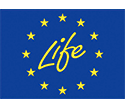The stork with a transmitter, which we wrote about in several previous messages, is unfortunately dead - he died as a result of an electric shock on a power line in Turkey.
At the end of May, the bird was brought to the Animal Rehabilitation Centre in Grzędy after the intervention of the inhabitants of Sztabin, who reported to Biebrza National Park that a stork chick had been thrown from one of the nests. At the Centre it turned out that a fragment of string swallowed by the stork was the reason for throwing him out of the nest by his parents. The string was probably brought by adult birds with food from the meadows or fields where storks were feeding. Because of the string, the young stork didn't want to eat and probably that's why he was thrown out of the nest. In the Animal Rehabilitation Centre, we removed the string from the digestive tract. Then the stork regained appetite and started to develop properly. Just before reaching volatility, he was selected to have a transmitter, thanks to which we could learn his fate after leaving the Centre. At the beginning of August, the bird flew out of Grzędy. Soon it turned out that he joined the group of 7 other storks. In September he flew over 1500 km to Turkey. Then, for about a month he was feeding in one place, which looks like on a waste dump on satellite images. In October it started to move further southward. He went to Greece for a few days and then returned to the European part of Turkey. Unfortunately, after returning to Turkey, the signal sent by our stork stopped in one place. When we started to suspect that something could have happened to our stork, we contacted ornithologists from Turkey, who could check what had happened on the spot. Yesterday, we received the sad news that our stork is dead. He died electrocuted.
This example shows that thanks to the cooperation of the local community with Biebrza National Park, it was possible to restore a young stork into nature that would have no chance without human help. Unfortunately, he was killed in an accident. As part of the LIFE project "Protection of the white stork in the river valleys of eastern Poland" implemented jointly with the Polish Society for Bird Protection and Łomża Landscape Park of the Narew Valley, works are being carried out in order to secure the elements of the power grid that are most dangerous for storks. Collisions with lines and electric shocks are the most common cause of death of young storks shortly after leaving the nest. We also appeal to you to clean strings and other rubbish that you will notice on the ground. They are a deadly dangerous threat to storks, because they cannot only be swallowed, but also get entangled around stork legs, cutting off blood supply.
We sincerely thank the ornithologists who contributed to learning about the end of the story of our stork, these were: Ian Harrison from the Ornithological Society of the Middle East, Kerem Boyla and the local ornithologist Özmen, who came to the site (shown below are his photographs). Of course, we would also like to thank those who were moved by the fate of the stork thrown out of the nest from Sztabin, who informed Biebrza National Park about it.
Next year, we are planning to put on new transmitters in order to have a more complete picture of how storks perform after the rehabilitation in our Centre in Grzędy.
By: Łukasz Krajewski (Biebrza National Park)
Photos: Animal Rehabilitation Centre
{gallery}/BocianLIFE/Aktualnosci/bocianBPN/{/gallery}

